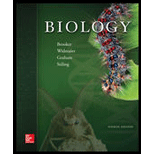
Concept explainers
Introduction: A mutation is a sudden change in the genome of an organism. The change obtained can be hereditary or can be influenced by means of a mutagen. The period of mutagen exposure determines the degree by which an organism is affected.
Answer to Problem 1TY
Correct answer: A mutation in which there is a removal of single base pair within the coding sequence of a gene and the inactivation of the protein encoded by the gene is called “a frameshift mutation”. Hence, the correct answer is option d.
Explanation of Solution
Reason for correct answer:
The addition and deletion of a single base pair in DNA results in frameshift mutations. In this type of mutation, there is a shifting of the reading frame at the site of mutation which results in the formation of non-functional genes.
Option d. is given as “a frameshift mutation.”
A type of mutation in which there is a deletion of single base pair in the coding sequence of a gene and the inactivation of the protein encoded by the genes is called “a frameshift mutation”. Hence, the correct answer is option d.
Reason for incorrect answer:
Option a. is given as “a silent mutation.”
A silent mutation is a type of point mutation and it does not affect the gene product. Hence, option a. is incorrect.
Option b. is given as “a missense mutation.”
The missense mutations take place by means of base substitutions. Hence, option b. is incorrect.
Option c. is given as, “a nonsense mutation.”
When the process of translation terminates by means of stop codon, the formed protein can be short and nonfunctional. Such mutation is called as nonsense mutation. Hence, option c. is incorrect.
Option e. is given as “both b and c.”
Both missense mutation and nonsense mutation cannot be expressed by the means addition or deletion of
Hence, the options a., b., c. and e. are incorrect.
A “frameshift mutation” is a mutation in which there is a removal of a single base pair within the coding sequence and the inactivation of the protein encoded by the gene.
Want to see more full solutions like this?
Chapter 14 Solutions
Biology
- Outline the negative feedback loop that allows us to maintain a healthy water concentration in our blood. You may use diagram if you wisharrow_forwardGive examples of fat soluble and non-fat soluble hormonesarrow_forwardJust click view full document and register so you can see the whole document. how do i access this. following from the previous question; https://www.bartleby.com/questions-and-answers/hi-hi-with-this-unit-assessment-psy4406-tp4-report-assessment-material-case-stydu-ms-alecia-moore.-o/5e09906a-5101-4297-a8f7-49449b0bb5a7. on Google this image comes up and i have signed/ payed for the service and unable to access the full document. are you able to copy and past to this response. please see the screenshot from google page. unfortunality its not allowing me attch the image can you please show me the mathmetic calculation/ workout for the reult sectionarrow_forward
- Skryf n kortkuns van die Egyptians pyramids vertel ñ story. Maximum 500 woordearrow_forward1.)What cross will result in half homozygous dominant offspring and half heterozygous offspring? 2.) What cross will result in all heterozygous offspring?arrow_forward1.Steroids like testosterone and estrogen are nonpolar and large (~18 carbons). Steroids diffuse through membranes without transporters. Compare and contrast the remaining substances and circle the three substances that can diffuse through a membrane the fastest, without a transporter. Put a square around the other substance that can also diffuse through a membrane (1000x slower but also without a transporter). Molecule Steroid H+ CO₂ Glucose (C6H12O6) H₂O Na+ N₂ Size (Small/Big) Big Nonpolar/Polar/ Nonpolar lonizedarrow_forward
- what are the answer from the bookarrow_forwardwhat is lung cancer why plants removes liquid water intead water vapoursarrow_forward*Example 2: Tracing the path of an autosomal dominant trait Trait: Neurofibromatosis Forms of the trait: The dominant form is neurofibromatosis, caused by the production of an abnormal form of the protein neurofibromin. Affected individuals show spots of abnormal skin pigmentation and non-cancerous tumors that can interfere with the nervous system and cause blindness. Some tumors can convert to a cancerous form. i The recessive form is a normal protein - in other words, no neurofibromatosis.moovi A typical pedigree for a family that carries neurofibromatosis is shown below. Note that carriers are not indicated with half-colored shapes in this chart. Use the letter "N" to indicate the dominant neurofibromatosis allele, and the letter "n" for the normal allele. Nn nn nn 2 nn Nn A 3 N-arrow_forward
 Human Heredity: Principles and Issues (MindTap Co...BiologyISBN:9781305251052Author:Michael CummingsPublisher:Cengage Learning
Human Heredity: Principles and Issues (MindTap Co...BiologyISBN:9781305251052Author:Michael CummingsPublisher:Cengage Learning Human Biology (MindTap Course List)BiologyISBN:9781305112100Author:Cecie Starr, Beverly McMillanPublisher:Cengage Learning
Human Biology (MindTap Course List)BiologyISBN:9781305112100Author:Cecie Starr, Beverly McMillanPublisher:Cengage Learning Concepts of BiologyBiologyISBN:9781938168116Author:Samantha Fowler, Rebecca Roush, James WisePublisher:OpenStax College
Concepts of BiologyBiologyISBN:9781938168116Author:Samantha Fowler, Rebecca Roush, James WisePublisher:OpenStax College Biology (MindTap Course List)BiologyISBN:9781337392938Author:Eldra Solomon, Charles Martin, Diana W. Martin, Linda R. BergPublisher:Cengage Learning
Biology (MindTap Course List)BiologyISBN:9781337392938Author:Eldra Solomon, Charles Martin, Diana W. Martin, Linda R. BergPublisher:Cengage Learning Biology 2eBiologyISBN:9781947172517Author:Matthew Douglas, Jung Choi, Mary Ann ClarkPublisher:OpenStax
Biology 2eBiologyISBN:9781947172517Author:Matthew Douglas, Jung Choi, Mary Ann ClarkPublisher:OpenStax





